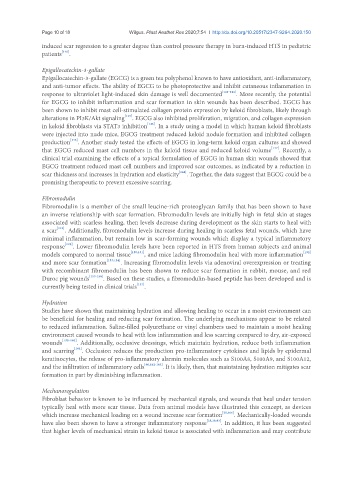Page 631 - Read Online
P. 631
Page 10 of 18 Wilgus. Plast Aesthet Res 2020;7:54 I http://dx.doi.org/10.20517/2347-9264.2020.150
induced scar regression to a greater degree than control pressure therapy in burn-induced HTS in pediatric
patients [140] .
Epigallocatechin-3-gallate
Epigallocatechin-3-gallate (EGCG) is a green tea polyphenol known to have antioxidant, anti-inflammatory,
and anti-tumor effects. The ability of EGCG to be photoprotective and inhibit cutaneous inflammation in
response to ultraviolet light-induced skin damage is well documented [141-144] . More recently, the potential
for EGCG to inhibit inflammation and scar formation in skin wounds has been described. EGCG has
been shown to inhibit mast cell-stimulated collagen protein expression by keloid fibroblasts, likely through
alterations in PI3K/Akt signaling [145] . EGCG also inhibited proliferation, migration, and collagen expression
in keloid fibroblasts via STAT3 inhibition [146] . In a study using a model in which human keloid fibroblasts
were injected into nude mice, EGCG treatment reduced keloid nodule formation and inhibited collagen
production [146] . Another study tested the effects of EGCG in long-term keloid organ cultures and showed
that EGCG reduced mast cell numbers in the keloid tissue and reduced keloid volume [147] . Recently, a
clinical trial examining the effects of a topical formulation of EGCG in human skin wounds showed that
EGCG treatment reduced mast cell numbers and improved scar outcomes, as indicated by a reduction in
scar thickness and increases in hydration and elasticity [148] . Together, the data suggest that EGCG could be a
promising therapeutic to prevent excessive scarring.
Fibromodulin
Fibromodulin is a member of the small leucine-rich proteoglycan family that has been shown to have
an inverse relationship with scar formation. Fibromodulin levels are initially high in fetal skin at stages
associated with scarless healing, then levels decrease during development as the skin starts to heal with
a scar [149] . Additionally, fibromodulin levels increase during healing in scarless fetal wounds, which have
minimal inflammation, but remain low in scar-forming wounds which display a typical inflammatory
response [149] . Lower fibromodulin levels have been reported in HTS from human subjects and animal
models compared to normal tissue [150,151] , and mice lacking fibromodulin heal with more inflammation [152]
and more scar formation [153,154] . Increasing fibromodulin levels via adenoviral overexpression or treating
with recombinant fibromodulin has been shown to reduce scar formation in rabbit, mouse, and red
Duroc pig wounds [153-156] . Based on these studies, a fibromodulin-based peptide has been developed and is
currently being tested in clinical trials [157] .
Hydration
Studies have shown that maintaining hydration and allowing healing to occur in a moist environment can
be beneficial for healing and reducing scar formation. The underlying mechanisms appear to be related
to reduced inflammation. Saline-filled polyurethane or vinyl chambers used to maintain a moist healing
environment caused wounds to heal with less inflammation and less scarring compared to dry, air-exposed
wounds [158-160] . Additionally, occlusive dressings, which maintain hydration, reduce both inflammation
and scarring [161] . Occlusion reduces the production pro-inflammatory cytokines and lipids by epidermal
keratinocytes, the release of pro-inflammatory alarmin molecules such as S100A8, S100A9, and S100A12,
and the infiltration of inflammatory cells [90,162-165] . It is likely, then, that maintaining hydration mitigates scar
formation in part by diminishing inflammation.
Mechanoregulation
Fibroblast behavior is known to be influenced by mechanical signals, and wounds that heal under tension
typically heal with more scar tissue. Data from animal models have illustrated this concept, as devices
which increase mechanical loading on a wound increase scar formation [28,166] . Mechanically-loaded wounds
have also been shown to have a stronger inflammatory response [28,29,93] . In addition, it has been suggested
that higher levels of mechanical strain in keloid tissue is associated with inflammation and may contribute

